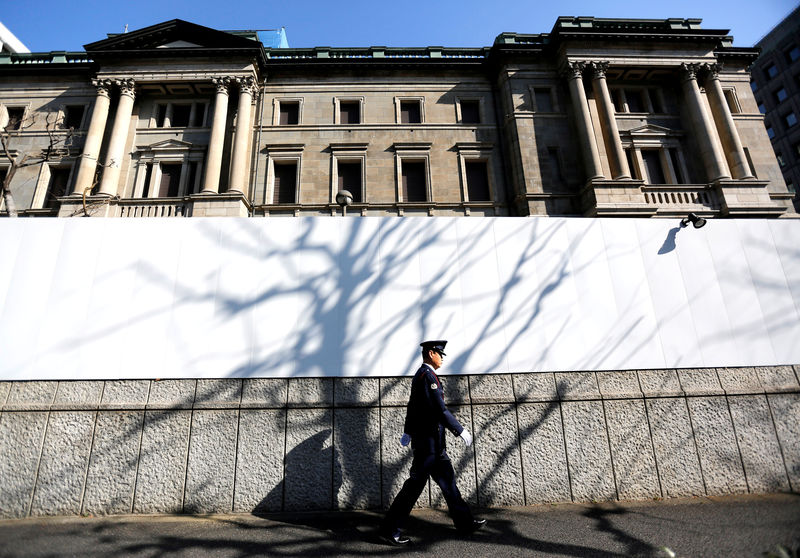 © Reuters. FILE PHOTO: A security guard walks past in front of the Bank of Japan headquarters in Tokyo
© Reuters. FILE PHOTO: A security guard walks past in front of the Bank of Japan headquarters in TokyoBy Leika Kihara
TOKYO (Reuters) – Rising global uncertainties could push Japan into recession and force the central bank to ramp up stimulus, the Bank of Japan’s former deputy governor Hirohide Yamaguchi said, reinforcing expectations an end to crisis-mode policies will remain distant.
Yamaguchi, who as a career central banker masterminded various monetary easing plans, said the BOJ’s policy tool-kit has become “quite small” after deploying a raft of radical measures to fire up inflation to its elusive 2 percent target.
But weakening global demand is hurting exports and the economy, he said, adding that the risk of Japan slipping into recession “isn’t small.”
The BOJ has said it will ease further only if the economy loses momentum to accelerate inflation to its target. Yamaguchi said the economy will indeed see such momentum weaken, thus forcing the central bank to top up monetary support.
“The BOJ will likely have to ponder additional easing at some point,” Yamaguchi told Reuters on Thursday before the European Central Bank’s policy meeting.
Given its dwindling ammunition, however, the central bank won’t act immediately to small changes in the economy, he added.
“It will act only when the economy is hit by a severe downturn, and when the momentum for hitting its price target is broken,” Yamaguchi said in his first interview with foreign media since retiring from the BOJ in 2013.
Trade tensions and slowing global growth have forced major central banks to pause in raising interest rates. The ECB on Thursday pushed out the timing of its first post-crisis rate hike, joining the U.S. Federal Reserve in putting tightening plans on hold.
Yamaguchi, who retains strong influence on and close contacts with incumbent BOJ policymakers, said any additional easing must be done in a way that does not expand too much the central bank’s already huge balance sheet.
“I think people at the BOJ are thinking of ways to do this,” he said. “The BOJ could reduce purchases of certain assets, while increasing buying of other assets,” said Yamaguchi, now chairman of private think tank Nikko Research Center.
On whether the BOJ could deepen negative rates or lower its long-term yield target if it were to ease further, Yamaguchi said: “I don’t think it’s absolutely impossible.”
Under a policy dubbed yield curve control (YCC), the BOJ now guides short-term rates at minus 0.1 percent and the 10-year bond yield around zero percent.
Even if the BOJ were to ramp up stimulus, it must be mindful of the need to eventually exit from ultra-loose policy, he said.
One way to make a future exit from easy policy smooth would be to offer more details now on the exit strategy, Yamaguchi said.
“It’s important to reveal the BOJ’s exit strategy when markets are calm and people believe the central bank won’t normalize policy any time soon,” he said.
POLICY TARGET CHANGE
Yamaguchi served as deputy to former BOJ Governor Masaaki Shirakawa, who was criticized for doing too little to fight a yen spike that hurt an economy already suffering from deflation.
Shirakawa’s successor Haruhiko Kuroda, who was hand-picked by Prime Minister Shinzo Abe to take bolder steps to beat deflation, deployed a massive asset-buying program in 2013. In 2016, the BOJ revamped its policy to one targeting interest rates.
Six years into Kuroda’s experiment, inflation is nowhere near the BOJ’s target and forcing the central bank to maintain massive stimulus despite the rising costs of prolonged easing.
Yamaguchi said it was hard to give high marks to Kuroda’s stimulus efforts, which are drying up bond market liquidity and straining financial institutions’ profits via ultra-low rates.
“It’s inappropriate to guide monetary policy with no consideration to the impact on the financial system and financial institutions’ business operations,” he said.
If insisting on meeting the price target causes too many demerits, the BOJ could consider replacing its 2 percent inflation goal with another target, Yamaguchi said.
He noted there were benefits to Shirakawa’s “gradualism” approach of taking incremental policy steps by carefully assessing the pros and cons of each measure.
“The biggest merit of gradualism is that you don’t need to resort to extreme, radical measures. You can switch policy or modify policy direction fairly easily,” he said. “That’s something very important when guiding monetary policy.”
Source: Investing.com




























